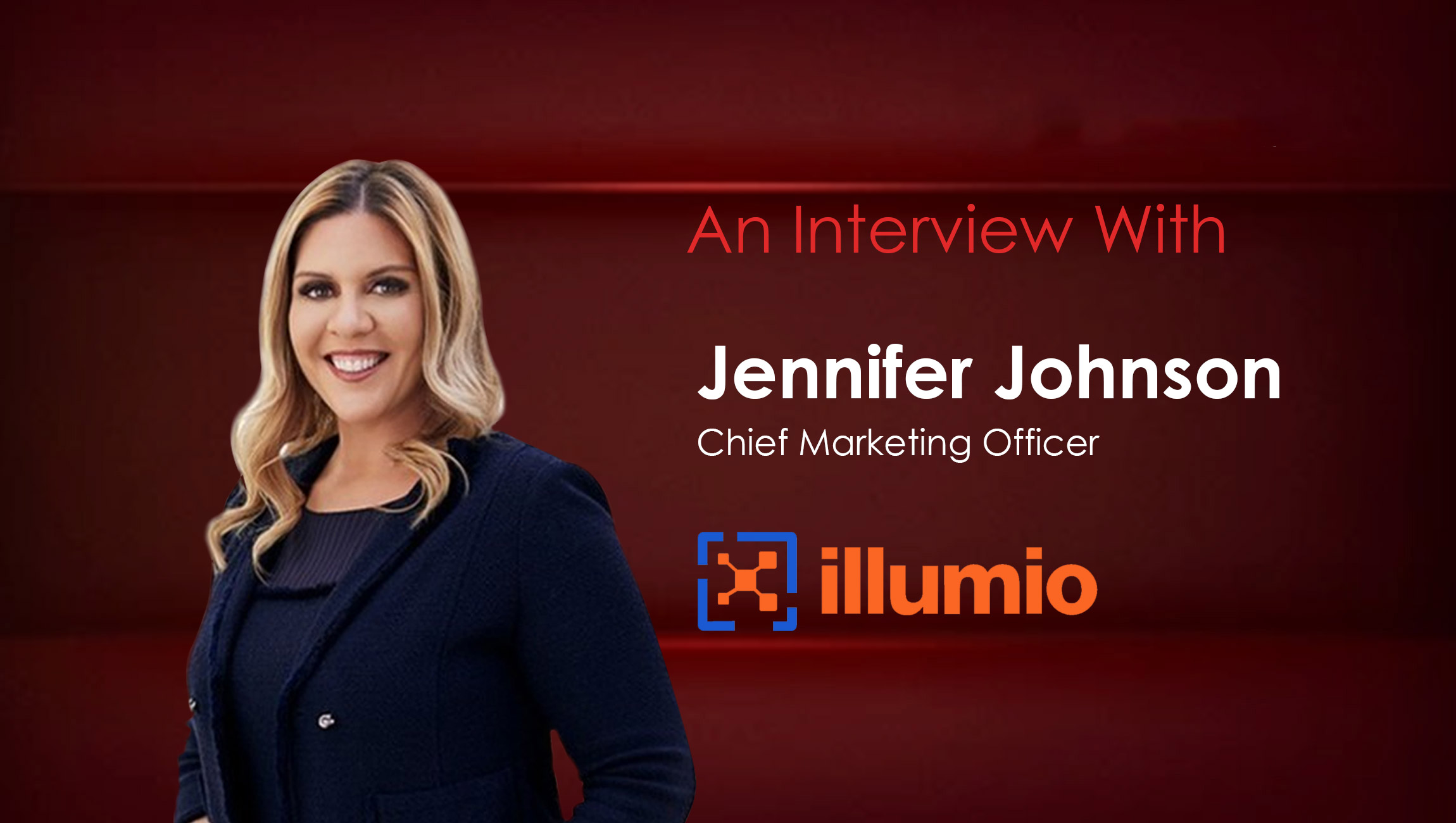Jennifer Johnson, CMO at Illumio chats about the importance of leveraging better narratives and storytelling experiences to drive marketing output in a digital-first environment:
________
Welcome to this MarTech Series chat, Jennifer, tell us about your marketing journey and highlights through the years and more about being CMO at Illumio…
I grew up in product marketing, which has been foundational for my marketing career. In product marketing, you serve as a hub – sitting between engineering and product to synthesize stories about what they’re building, then translating those stories into what will resonate with the market. Product marketers have a 360-degree view of a company and touch every facet of the business.
I’ve been a CMO for a little over 10 years, working specifically with hypergrowth, private companies in the enterprise tech and cybersecurity spaces. While each experience has been unique, every organization I’ve worked with has needed to create a differentiated point of view in a saturated marketplace. My last two roles (at Amplitude and Tenable) largely centered around narrative development and positioning each organization to go public. Both were incredibly rewarding experiences.
I joined Illumio’s board in December of 2020 and feel lucky to have had the chance to get to know the company before joining as CMO. I think the world of the Illumio leadership team and am proud of the work that we’re doing for our customers – we’re making a real difference in helping organizations minimize risk and safeguard their businesses against ransomware attacks. It also felt like the right time in the market’s lifecycle to join Illumio. The Zero Trust Segmentation category is at an inflection point, and this is the stage of growth where I’m most impactful. At Illumio, I can do meaningful work with a team I really love.
Marketing Technology News : Illumio Collaborates with IBM Security to Bolster Cyber Resilience for Modern Organizations
As a marketing leader, what are some of the core marketing processes and strategies that you feel are crucial to B2B environments today?
I look at marketing as air and ground. Air cover is the narrative you’re telling the market – what problem you’re solving, why you’re relevant, why you’re differentiated, and why people should listen. We know that every market worth being in is crowded and noisy, so the skill of positioning and creating a differentiated narrative and perspective is critical.
The cybersecurity industry often over rotates on messaging and leaves out the “why” – i.e., neglects the positioning. That’s why so many vendors in this space seem to be saying the same thing, and ultimately, that’s a disservice to our customers and prospects. Organizations need to understand what they’re buying, and it’s our job, as marketers, to help them understand why they need our solution on top of every other piece of technology in their security stack. All of that comes back to the art of positioning. I always say: positioning first, messaging second.
Then there’s the ground game: first, taking that narrative and transferring it into demand, then taking that demand and moving it one step further into revenue. I know it sounds simple, but in this digital-first world, where customers interact with brands across multiple channels before they even connect with a human representative, being able to think three dimensionally and leverage data to understand the customer journey as it evolves is essential.
When it comes to the changing scope of marketing today, what key trends are you following?
The first is the transition to digital-first engagement. I’ve seen multiple stats but I believe the consensus is 60 to 70 percent of sales cycles today are done before a prospect even talks to anyone at the company. Think about the world we live in: the top of funnel awareness and initial education is no longer led by in-person interactions, it’s generated by peer references, social media, crowdsourcing review sites, online research, press releases, and news articles.
We don’t really know what happens before a customer engages with us – there are a host of avenues that generate that initial first impression before we have a direct line of communication (and we can only tie those engagements to revenue so much). But putting the right focus at the top of the funnel is crucial to educate the market and shape your narrative in the right way.
Another thing to remember, especially in the world of cybersecurity, is that you need to be the safe choice for customers. Many organizations don’t want to be early adopters, so it’s important to assure organizations that others have gone before them, they’ve been successful, and they’ve seen value in your solution. This is where channels such as analyst research and customer advocacy play a vital role in market education and both company and technology validation. It’s social proof.
Lastly, the customer journey is no longer linear. Organizations must take a more curated approach to helping customers through a journey, instead of one-size-fits-all. Understanding the dynamics of your customers and what behaviors or actions move the needle is the most important thing, and data analytics plays a crucial role in helping you do that.
Marketing Technology News : MarTech Interview with Ritu Kapoor, CMO at Lob
Marketers still struggle with many base level challenges: take us through some of the most common ones you’ve seen teams struggle with and the best practices you’d share that can help.
While I believe this is changing, traditionally marketers are not known for being data-driven. Data-driven insights enable us to understand the customer journey, how customers make decisions and what programs are the most valuable in helping them. We all talk about being data driven and using data to make good decisions, but in practice it requires a mindset shift in many marketing teams. Having an analytics function is not enough if that data isn’t transparent and provided to all of the teams that need it to make decisions.
It’s also important to remember that we, as a joint sales, marketing, and partnerships team, support one single company objective and number. We are all here together to grow the business and maximize the value for our customers. Understanding contribution to pipeline and revenue by channel is important, but if one team achieves and the company underachieves, the entire team underachieves. Also, the marketing team’s world does not end at a Marketing Qualified Lead (MQL). MQLs are closer to top of funnel. We need to be thinking about revenue and pipeline. It’s the same issue as contribution by source – if the MQL goal is reached but pipeline doesn’t grow, that is not a marketing success.
We’d love to hear a few predictions you have in mind for the future of B2B marketing!
B2B will continue to take the best of B2C and apply it. Historically, B2B companies have often assumed that they’re selling to an organization (a brand, a logo, etc.), when in actuality they’re still selling to people. I love that as of late, we’ve seen more B2B brands apply B2C thinking in their messaging, positioning, and design – making it simpler for people to understand and digest the technology and its unique value proposition. At the end of the day, we all crave simplicity, and that’s something that B2C does exceptionally well. I expect B2B brands to continue to lean into more empathetic, relatable, and simplified messaging.
We’re going to see the pendulum swing back to in-person. People are clamoring to be in-person again. At least for the remainder of the calendar year, you’ll see people jumping on the opportunity to return to the workplace and to in-person events. Eventually, I believe the pendulum will swing back and we’ll settle back into a more hybrid world, but right now, the appetite for in-person engagement is high.
The DNA of the CMO is evolving. If you look at the last two decades, CMOs came from all different backgrounds. Initially, CMOs came from communications and branding backgrounds when marketing was more squarely tied to advertising and brand equity creation. In the early 2010s, technology such as marketing automation became more mainstream – inspiring CMOs to be more data-driven and enabling them to tie their work to the revenue stream for the first time. This drove a wave of CMOs from quantitative, analytical, and operations backgrounds. Now we’re in a third wave – with CMOs coming from a product marketing background. The skills developed as a product marketer are sorely needed in the dynamic and fast-moving markets we live in today. The need to understand and shape market dynamics and have an in-depth view of the customer and their challenges is becoming the battleground for creating and dominating categories.
Marketing Technology News : It’s Time to Stop Calling Privacy a Tech Problem: How Publishers Can Succeed in the Trust-Based Ecosystem

Illumio is a pioneer and market leader of Zero Trust segmentation, prevents breaches from becoming cyber disasters.
Jennifer Johnson is CMO at Illumio.
Missed The Latest Episode of The SalesStar Podcast? Have a quick listen here!
Episode 121: Sales Enablement Trends for 2022: with Carson Conant, Founder and CEO at MediaFly
Episode 120: The Future of Customer Success with Guy Nirpaz, Founder and CEO at Totango
Episode 119: Sales Trends that Generate Better ROI: with Scott Smyth, VP Global Sales at HG Insights











